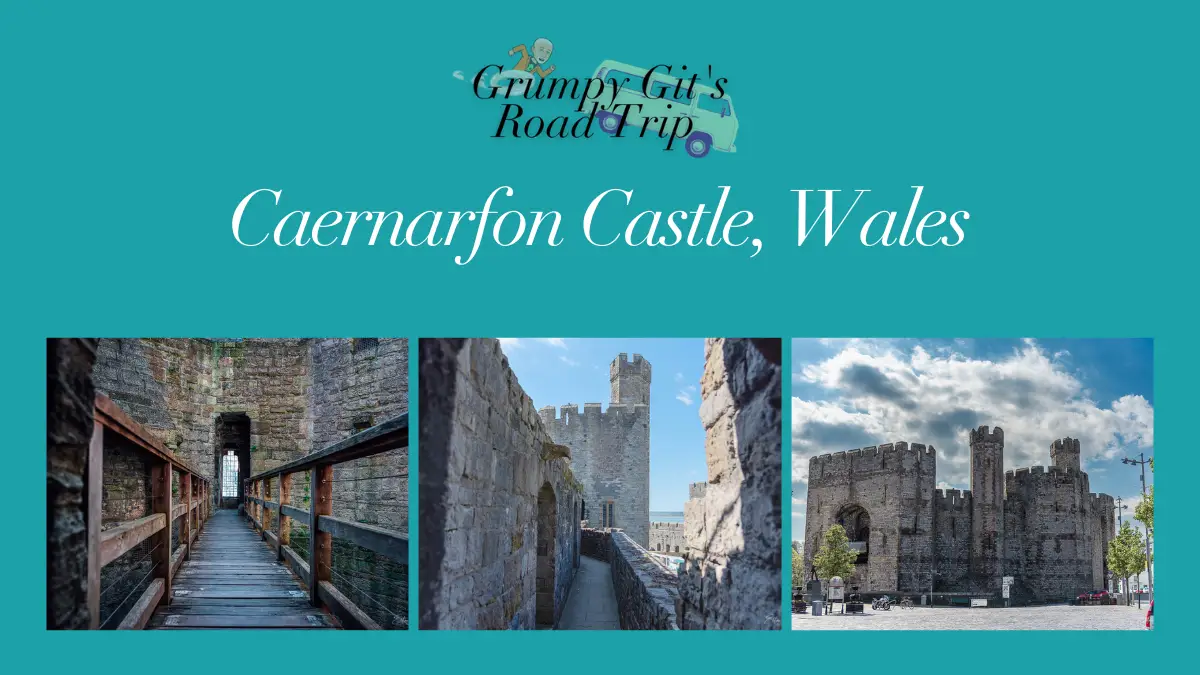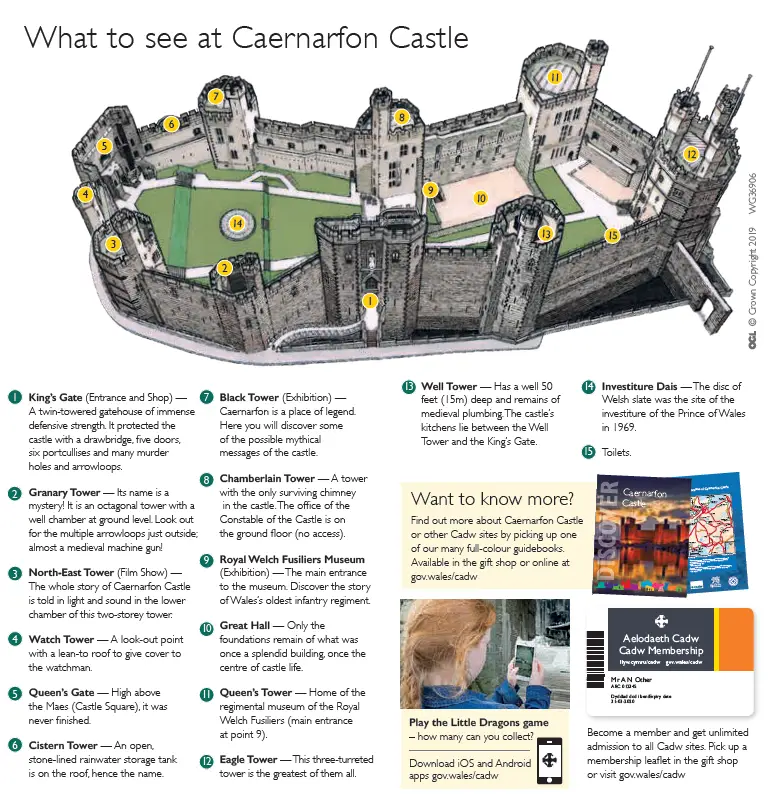
Key facts about Caernarfon Castle
Caernarfon Castle is a medieval castle located in the town of Caernarfon, in the county of Gwynedd, Wales.
It was built by King Edward I of England in the late 13th century as part of his campaign to conquer Wales and incorporate it into his kingdom.
The castle is a World Heritage site.
It has polygonal walls and eight towers, four of which are polygonal and four of which are round.
The Great Tower, also known as the White Tower, is the largest and most impressive of the castle's towers. It stands over 100 feet tall and has walls that are over 20 feet thick.
The castle has a number of ornate buildings within its walls, including the King's Hall and the Chapel Royal.
In the 14th century, Owain Glyndwr led a rebellion against English rule and declared himself Prince of Wales. He took control of Caernarfon Castle and used it as his base of operations.
The castle has been used as a venue for royal ceremonies, including the investiture of Prince Charles as the Prince of Wales in 1969.
It is open to the public year-round and offers guided tours, as well as the opportunity to explore the castle's grounds and buildings on your own.
The castle towers are called the Eagle Tower, the Queen's Tower, the King's Tower, the Banner Tower, the Well Tower, the Black Tower, the Chamberlain Tower, and the Great Tower.
The Great Tower was used as the castle's keep, or main defensive structure, and would have housed the castle's lord and his family.
My visit to and thoughts of Caernarfon Castle
One of the goals of my overall photography project is to visit as many of the over 1000 castles in the UK. Many of these castles are nothing more than a few stones left in place, or perhaps a foundation of some sort. There are only a few that are still in useable condition. Caernarfon Castle is one of those castles. It remains in fairly remarkable condition given its history and age.
When approaching the town of Caernarfon, Caernarfon Castle is a very prominent feature on the horizon. It stands tall and proud against its surroundings and the closer you get the more in awe you become of its size.
There is parking right next to the castle but I suspect in peak seasons it may be difficult to find parking here. I visited in April 2022 so there were plenty of spaces.

Image copyright: CADW
In the above image/map of Caernarfon Castle, it states entry is via Kings Gate (1). When I visited in April of 2022 there was a lot of scaffolding up around Kings Gate. The entrance and shop were in fact in Eagle Tower (12)
When you enter through the Tower/entrance and up the stairs that lead you onto the inner bailey you get to truly appreciate the sheer scale of Caernarfon Castle. Caernarfon castle truly is a testament to medieval architecture and I found myself imagining what it must have been like living within these walls back in the 1200s when the castle was originally completed, as royalty, residents, staff and military personnel. The lively get-togethers in the Great Hall, The manic scampering of bowmen and infantry when defending the castle. All thanks to historical documentaries of course.
One thing I noticed during the exploration of the castle walls and its numerous rooms, corridors and chambers was that people in the 1200s were short. I'm only 6ft these days, thanks to ageing, yet I still had to put my head down to walk down most of the corridors. Also, they were clearly not fast food eaters because my shoulders touched both walls as I walked down some of the defensive corridors. The corridors which provided access to the arrow slits scattered around the castle walls and towers. How fully armoured bowmen and infantry managed to get around in these corridors is something I still ponder to this day. Answers on a postcard please if you know something I don't!
The castle contains many museum exhibits within the walls and towers including the Royal Welch Fusiliers Museum, a legends exhibition detailing some of the legends associated with Caernarfon Castle and a film show presenting the timeline history of the castle.
I did a pretty rushed walkthrough of the castle and it still took me a couple of hours. It would easily make for a day out if you were to read all the various plagues around the castle and in the museums and exhibitions and had a picnic in one of the baileys.
Some of the stairwells are very dodgy, especially the spiral ones which often don't provide much surface for your feet! There are certainly some challenges for those like me that suffer from vertigo. I did get to the top of one of the towers, I couldn't even tell you which one it was now as I was so focused (and terrified) about every step I was taking that my brain seems to have lost the memory of which tower it was on.
History of Caernarfon Castle
History tells us that prior to building Caernarfon Castle, a motte and bailey castle stood on the site built in c1093 and prior to this a Roman Fort.
Caernarfon Castle is a medieval castle in Caernarfon, Gwynedd, Wales. It was built by King Edward I of England and his master castle builder, James of St Georgein with work beginning in 1283, as one of a series of castles known as the Ring of Iron, or the Ring of Castles, to conquer the Welsh and consolidate English rule. Along with the castle itself, town walls and a quay were also built. It took 47 years to complete the work (although some parts were never actually completed) at a mindblowing £25,000 at the time (remember, we're talking over 700 years ago here!)
The castle is a World Heritage site, and its impressive polygonal walls and towers are a major tourist attraction and truly awe-inspiring.
But Caernarfon Castle isn't just a historical relic – it's also a popular venue for events, including weddings, concerts, and festivals. Its location on the banks of the Menai Strait, with beautiful views of Snowdonia National Park, makes it a unique and picturesque setting.
One of the most distinctive features of Caernarfon Castle, that are unmissable at first sight of the castle, is its polygonal walls, which are made up of blocks of stone from the local area and are further reinforced with round towers. The castle has a total of eight towers, four of which are polygonal and four of which are round. The polygonal towers are the Eagle Tower, the Queen's Tower, the King's Tower, and the Banner Tower. The round towers are the Well Tower, the Black Tower, the Chamberlain Tower, and the Great Tower.
The Great Tower, also known as the White Tower, is the largest and most impressive of the castle's towers. It stands over 100 feet tall and has walls that are over 20 feet thick. The Great Tower was used as the castle's keep, or main defensive structure, and would have housed the castle's lord and his family. It also served as a lookout point, with arrow slits and windows providing views of the surrounding area.
The castle's walls and towers are not the only impressive features – the castle also has a number of elegant and ornate buildings within its walls. These include the King's Hall, which was used for feasts and banquets, and the Chapel Royal, which was used for religious services.
However, the castle was not just a symbol of English domination – it was also a centre of Welsh resistance. In the 14th century, Owain Glyndwr led a rebellion against English rule and declared himself Prince of Wales. He took control of Caernarfon Castle and used it as his base of operations. The castle was eventually retaken by the English, but the rebellion left a lasting mark on the castle's history.
Despite its history as a site of conflict, Caernarfon Castle has also played a role in more peaceful events. It has been used as a venue for royal ceremonies, including the investiture of Prince Charles as the Prince of Wales in 1969.
Caernarfon Castle today
Today, Caernarfon Castle is a popular tourist attraction and a major part of Wales' cultural heritage. It is open to the public year-round and offers guided tours, as well as the opportunity to explore the castle's grounds and buildings on your own.
In addition to its historical and cultural significance, Caernarfon Castle is also a beautiful and picturesque setting for events. Its location on the Menai Strait, with views of Snowdonia National Park, makes it a unique and memorable venue for weddings, concerts, and festivals.
So if you're interested in history, and culture, or just looking for a beautiful and unique venue for an event, consider visiting Caernarfon Castle. It's a must-see destination for anyone visiting Wales.
Conclusion of Caernarfon Castle
If like me, you are interested in history and architecture then you HAVE to put Caernarfon Castle on your list of sites to visit. With over 700 years of history and a true marvel of medieval masonry work, you will not be disappointed.
If you have visited Caernarfon Castle please comment below with your thoughts and experience of your visit 🙏
Sources: CADW

